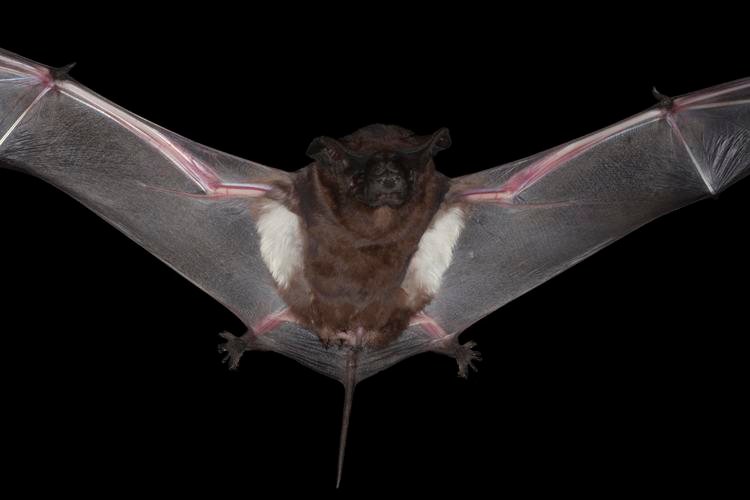Pocketed Free-Tailed Bat: Nyctinomops Femorosaccus

The pocketed free-tailed bat is dark in color and is known for its distinctive tail. This species feeds on echolocation-detected flying insects high above ponds, streams, or arid desert habitats. Peak activity hours are during the night while this bat rests during the day.
Learn More: Noctural Bat Habits
Characteristics Of The Pocketed Free-Tailed Bat
The Pocketed Free-tailed Bat has grooved lips with a large, broadhead. The face has plenty of stiff hair with tips like spoons. A tragus is present, and thick and leathery ears are present. In the middle of the forehead, these ears are joined.
This bat’s wings are long and narrow. Beyond the edge of the uropatagium, the tail extends far. That fur is short and slick. From the femur’s inner side to the middle of the tibia, a fold of skin stretches. A pocket on the underside of the interfemoral membrane is produced by this fold, which gives the animal its common name, the Pocketed Free-tailed Bat. 1Go To Source animaldiversity.org -“Nyctinomops femorosaccus pocketed free-tailed bat”
Pocketed Free-Tailed Bat Size
The average pocketed free-tailed bat measures:
- Total Length: 112 mm
- Tail Length: 46 mm
- Feet Length: 10 mm
- Ear Length: 23 mm
- Forearm Length: 46 mm
Habitat Of The Pocketed Free-Tailed Bat

In different environments such as caves, as well as structures constructed by people such as bridges and attics, free-tailed bats are found. They are most frequently found in caves with large rooms and high ceilings, but also in hollow trees that roost. In these locations, they roost where they hang upside down to rest or sleep. The bats breed, nest, and interact with each other in these roosting locations. 2Go To Source biokids.umich.edu -“Brazilian free-tailed bat Tadarida brasiliensis”
Pocketed Free-Tailed Bat Range
N. Femorosacca occurs from southern California, central Arizona, southern New Mexico, and western Texas, south to Mexico, including Baja California, in western North America. It is thought that the species is non-migratory. The known altitudinal distribution is from about 7,300 feet to near sea level. In southern California, breeding populations have recently been identified.
Only in Big Bend National Park and Brewster County, the pocketed free-tailed bat is known to exist in Texas. 3Go To Source tpwd.texas.gov -“Pocketed Free-tailed Bat (Nyctinomops femorosacca)”
Free-Tailed Bat Diet
The pocketed free-tailed bat species feeds on echolocation-detected flying insects high above ponds, streams, or arid desert habitats. The main food is large moths, but this bat hunts a wide variety of insects. The flight during foraging is direct and swift. 4Go To Source nrm.dfg.ca.gov -“POCKETED FREE-TAILED BAT Nyctinomops femorosaccus”
Top 4 Predators Of The Pocketed Free-Tailed Bat
Occasionally predators will gain access and feed on the free-tailed bats. Predators also will catch young bats that have fallen from the roost. Common animals that feed on this species include:
- Raccoons
- Owls
- Snakes
- House Cats
Typical Free-Tailed Bat Behavior

This species is a semiarid desert land inhabitant. Day roosts have been found to be used in caves and cracks in cliffs and under the roof tiles of buildings. Studies carried out in Big Bend (TX state park) since the species’ initial discovery has shown that this species lives year-round in the region.
The Pocketed Free-Tailed Bat is an inhabitant of semiarid desert lands and roosts in caves/rock crevices of rugged canyon country. It is a colonial rooster, and it is thought that colonies are small and contain less than 100 bats. Limited research indicates that males and females roost together.
These bats leave their day roost to forage late at night, showing swift, powerful flight. On March 17, 1955, Philip Krutzsch found a daytime roost in a crevice in front of a cliff in San Diego County, California, with a colony of 50-60 of these bats.
At 6:15 p.m., the first bats left the colony; others followed for another half hour in twos and threes. Before taking powered flight, the bats fell from 3 to 5 ft. to gain speed. A rapid, complete wing beat appeared to be their flight. They uttered a shrill, sharp, high-pitched, chattering call as they first took flight, which was repeated while the bats were in full flight. While on the roost, they also squeaked a lot. Krutzsch described this bat’s smell as similar, but not quite as strong, to that of the Brazilian free-tailed bat.
This rapid-flying bat hunted insects during flight. Moths, crickets, flying ants, stinkbugs, froghoppers and leafhoppers, lacewings, and unidentified insects have been found in the stomachs of 13 bats captured in Big Bend National Park. 5Go To Source depts.ttu.edu -“POCKETED FREE-TAILED BAT Nyctinomops femorosaccus (Merriam 1884)”
Pocketed Free-Tailed Bat Reproduction
Data on reproduction in this species is scarce, but females give birth to a single young bat between late June and early July. From June 10 to July 12 in Big Bend National Park, pregnant bats, each containing a single embryo, and lactating females from June 20 to August 17, were captured. From August 29 to November 27, flying juveniles were captured.
Threats To The Pocketed Free-Tailed Species
There are no known major threats to the pocketed free-tailed bat species. Direct and indirect effects of pesticides, human disturbance of roosting sites, destruction of roosts/foraging habitats, impacts of livestock grazing on habitat quality, and impacts of water management on riparian habitats are potential or highly localized threats.
Food does not appear to restrict the population size in Texas. This species is not one of those known to be killed in significant numbers regularly at wind power plants. Research estimates wind turbines killed less than 200 free-tailed bats in the United States from 2000 to 2011. This species was not known to be affected by white-nose syndrome as of mid-2014. 6Go To Source explorer.natureserve.org -“Nyctinomops femorosaccus Pocketed Free-tailed Bat”
References:
- Lancaster, E. 2000. “Nyctinomops femorosaccus” (On-line), Animal Diversity Web. Accessed January 12, 2021 at https://animaldiversity.org/accounts/Nyctinomops_femorosaccus/
- Sosnicki, J. 2012. “Tadarida brasiliensis” (On-line), Animal Diversity Web. Accessed January 12, 2021 at http://www.biokids.umich.edu/accounts/Tadarida_brasiliensis/
- “Pocketed Free-Tailed Bat (Nyctinomops Femorosacca).” Texas Parks & Wildlife, Texas Parks and Wildlife Department, tpwd.texas.gov/huntwild/wild/species/pocketfreetail. Accessed 12 Jan. 2021.
- “A Species Account of the Pocketed Free-Tailed Bat (Nyctinomops Femorosaccus) | Mammals of Texas | Natural Science Research Laboratory | TTU.” Texas Tech University Natural Science Research Laboratory, University of Texas Press, 2016, www.depts.ttu.edu/nsrl/mammals-of-texas-online-edition/Accounts_Chiroptera/Nyctinomops_femorosaccus.php.
- “California Wildlife Habitat Relationships System California Department of Fish and Wildlife California Interagency Wildlife Task Group.” California Department Of Fish And Wildlife, California Depart. of Fish and Game, May 2020, nrm.dfg.ca.gov/FileHandler.ashx?DocumentID=2353.
- “NatureServe Explorer 2.0.” NatureServe Explorer, NatureServe, explorer.natureserve.org/Taxon/ELEMENT_GLOBAL.2.102156/Nyctinomops_femorosaccus. Accessed 12 Jan. 2021.
